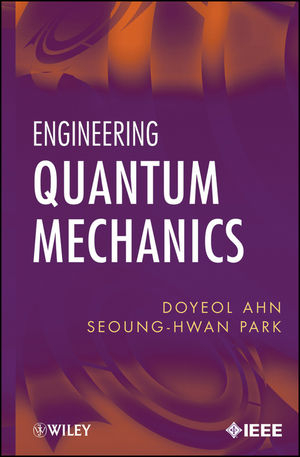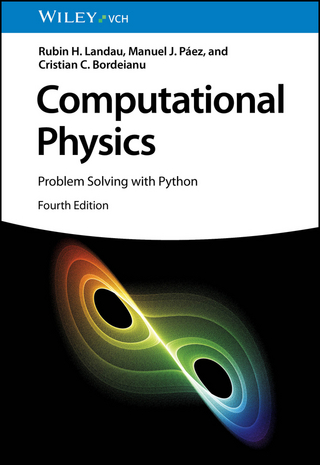
Engineering Quantum Mechanics
Wiley-IEEE Press (Verlag)
978-0-470-10763-8 (ISBN)
There has been growing interest in the model of semiconductor lasers with non-Markovian relaxation. Introducing senior and graduate students and research scientists to quantum mechanics concepts, which are becoming an essential tool in modern engineering, Engineering Quantum Mechanics develops a non-Markovian model for the optical gain of semiconductor, taking into account the rigorous electronic band-structure and the non-Markovian relaxation using the quantum statistical reduced-density operator formalism. Example programs based on Fortran 77 are provided for band-structures of zinc-blende and wurtzite quantum wells.
DOYEOL AHN, PHD, is WB Distinguished Professor of Quantum Electronics in the Department of Electrical and Computer Engineering at the University of Seoul (Korea). A Fellow of the American Physical Society and an IEEE Fellow, he has coauthored more than 190 refereed journal papers and three book chapters, and holds seven U.S. patents to date. SEOUNG-HWAN PARK, PHD, is Professor in the Department of Electronics Engineering at the Catholic University of Daegu (Korea). He has written two book chapters and coauthored more than 160 refereed journal and conference papers.
Preface vii PART I Fundamentals 1
1 Basic Quantum Mechanics 3
1.1 Measurements and Probability 3
1.2 Dirac Formulation 4
1.3 Brief Detour to Classical Mechanics 8
1.4 A Road to Quantum Mechanics 14
1.5 The Uncertainty Principle 21
1.6 The Harmonic Oscillator 22
1.7 Angular Momentum Eigenstates 29
1.8 Quantization of Electromagnetic Fields 35
1.9 Perturbation Theory 38
Problems 41
References 43
2 Basic Quantum Statistical Mechanics 45
2.1 Elementary Statistical Mechanics 45
2.2 Second Quantization 51
2.3 Density Operators 54
2.4 The Coherent State 58
2.5 The Squeezed State 62
2.6 Coherent Interactions Between Atoms and Fields 68
2.7 The Jaynes–Cummings Model 69
Problems 71
References 72
3 Elementary Theory of Electronic Band Structure in Semiconductors 73
3.1 Bloch Theorem and Effective Mass Theory 73
3.2 The Luttinger–Kohn Hamiltonian 84
3.3 The Zinc Blende Hamiltonian 105
3.4 The Wurtzite Hamiltonian 114
3.5 Band Structure of Zinc Blende and Wurtzite Semiconductors 123
3.6 Crystal Orientation Effects on a Zinc Blende Hamiltonian 135
3.7 Crystal Orientation Effects on a Wurtzite Hamiltonian 152
Problems 168
References 169
PART II Modern Applications 171
4 Quantum Information Science 173
4.1 Quantum Bits and Tensor Products 173
4.2 Quantum Entanglement 175
4.3 Quantum Teleportation 178
4.4 Evolution of the Quantum State: Quantum Information Processing 180
4.5 A Measure of Information 183
4.6 Quantum Black Holes 184
Appendix A: Derivation of Equation (4.82) 202
Appendix B: Derivation of Equations (4.93) and (4.106) 203
Problems 204
References 205
5 Modern Semiconductor Laser Theory 207
5.1 Density Operator Description of Optical Interactions 209
5.2 The Time-Convolutionless Equation 211
5.3 The Theory of Non-Markovian Optical Gain in Semiconductor Lasers 223
5.4 Optical Gain of a Quantum Well Laser with Non-Markovian Relaxation and Many-Body Effects 232
5.5 Numerical Methods for Valence Band Structure in Nanostructures 235
5.6 Zinc Blende Bulk and Quantum Well Structures 252
5.7 Wurtzite Bulk and Quantum Well Structures 258
5.8 Quantum Wires and Quantum Dots 265
Appendix: Fortran 77 Code for the Band Structure 274
Problems 286
References 287
Index 289
| Reihe/Serie | IEEE Press |
|---|---|
| Sprache | englisch |
| Maße | 160 x 244 mm |
| Gewicht | 603 g |
| Themenwelt | Naturwissenschaften ► Physik / Astronomie |
| Technik ► Elektrotechnik / Energietechnik | |
| ISBN-10 | 0-470-10763-4 / 0470107634 |
| ISBN-13 | 978-0-470-10763-8 / 9780470107638 |
| Zustand | Neuware |
| Haben Sie eine Frage zum Produkt? |
aus dem Bereich


